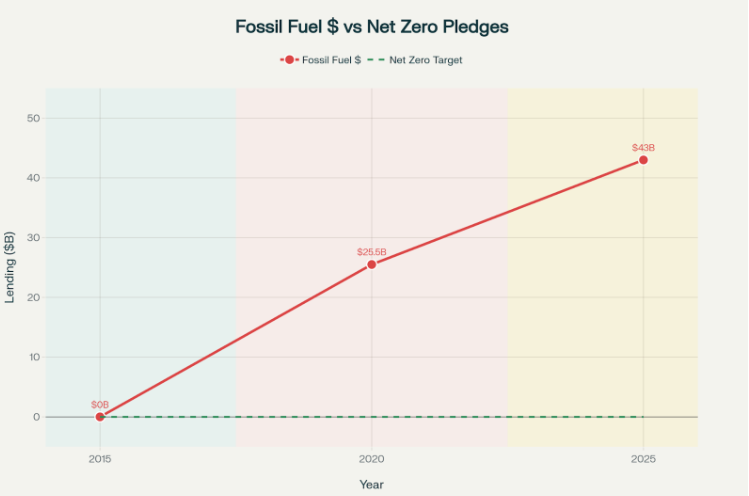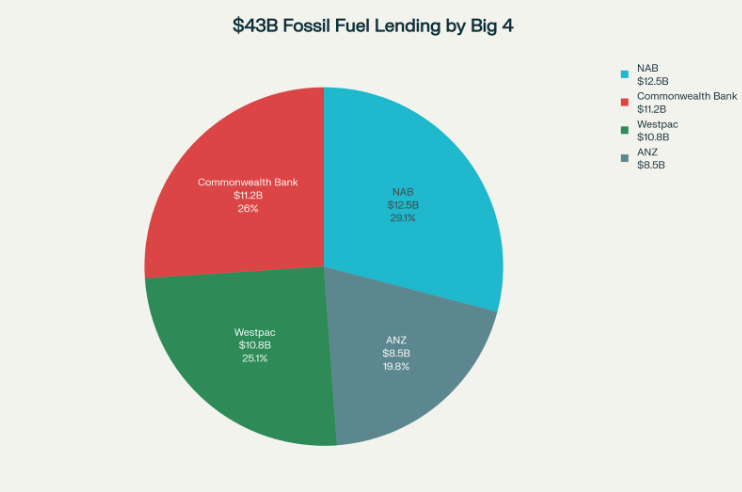Australia’s four major banks have provided more than $43 billion in loans to fossil fuel companies. These funds flowed even after they signed to support the Paris Agreement. The figure reflects research released this year by market analysts and climate advocacy groups. Data reveal these banks publicly pledged net zero targets but continued investments in coal, oil, and gas.
Net Zero Pledges and Ongoing Investments
The banks reiterated their commitment to reach net zero emissions by 2050. They claimed they would align lending with pathways to a maximum temperature rise of 1.5°C above pre-industrial levels. However, records show billions earmarked for fossil fuel expansion projects have continued. The lending took place between the signing of the Paris Agreement and the present.

Timeline of Pledges vs. Actions
Breakdown of Lending by Bank
National Australia Bank, Commonwealth Bank, Westpac, and ANZ all feature in market reports on fossil fuel financing. NAB provided $4.5 billion in corporate finance to coal and gas operations just in 2021 and 2022. The majority of finance went to companies with plans to expand fossil fuel production. Westpac, according to its latest climate policy, does not yet assess Scope 3 emissions for fossil fuel customers. Market Forces described NAB as Australia’s most regressive major bank in terms of climate credentials.

Lending Breakdown by Big 4 banks
Loopholes and Criticism
Analysts and climate campaigners pointed to policy loopholes in net zero commitments. NAB only requires Paris-aligned transition plans from most fossil fuel extraction companies starting October 2025. Critics argued that this long lead time allows further support for industry expansion. Shareholder resolutions called for binding policies to end finance for new coal, oil, and gas altogether. More than 28% of NAB shareholders voted for stricter climate action at the 2023 annual general meeting.
Climate Risks and Financial System Impact
Banks faced rising scrutiny over risks from continued fossil fuel exposure. The Climate Council highlighted risks to Australia’s financial system linked to climate change. Lending for coal and gas expansion increases the risk profile for banks and superannuation funds. A recent assessment found $57.5 billion in lending to companies and projects expanding supply since 2015. Superannuation funds held at least $25.1 billion in coal, oil, and gas expansion assets as of December 2022.
Impact of Paris Agreement Commitments
If banks commit to Paris-aligned financing but still fund fossil fuels, they risk legal action. The Commonwealth Bank previously settled lawsuits from shareholders over climate risk strategies and fossil fuel investments. Analysts suggested that banks expose themselves to reputational and regulatory risks by not closing the gap between policy and practice.
Green Finance and Recent Developments
Despite fossil fuel funding figures, banks have announced record ‘green finance’ investments. One Big Four bank claimed to exceed its climate finance target for 2025. On 10 November, a major bank announced more than AU$2 billion lent to ‘green business’ projects over the year. Critics contended this does not offset the impact of ongoing fossil fuel finance.

Fossil Fuel vs Green Finance
Future Policy Shifts
Major banks have promised to review climate targets following mergers and policy changes. Bank Australia set a net zero by 2035 pledge, including stopping loans for new fossil-fuel vehicles. Changes in climate policy may prompt the sector to reset baselines and new aligned pathways. Advocates called for stronger sector-wide measures to align lending fully with zero emissions transition.
Global Context and Pressure
Australia joined global moves to invest in renewable energy infrastructure. National targets include cutting greenhouse emissions by 43% below 2005 levels by 2030. The federal government allocated funding for large-scale solar and wind projects. Market observers noted the contrast between national green ambitions and private fossil fuel finance. Domestic banks’ continued fossil fuel support drew criticism in international forums.
Shareholder and Community Actions
Court cases, protests, and shareholder activism heightened scrutiny of bank policies. Investors increasingly demanded concrete plans for banks to divest from coal, oil and gas expansion. Advocacy groups urged banks to close loopholes and deliver on net zero commitments. Market Forces published ongoing reports assessing policies and tracing finance flows to fossil fuel projects.
Also Read: Socceroos Loss to Venezuela in Friendly Match Affects World Cup Draw Prospects
Regulatory Environment and Future Outlook
Australian regulators and central banks acknowledged transition and physical risks from climate change. Reports warned that failing to address emissions in lending exposes the financial system to shocks. Looming regulatory reforms may create new obligations for banks to disclose and manage climate risk. Banks face public and shareholder calls to rapidly phase down fossil fuel support.
Facts and Figures
- $43 billion lent by Big Four banks to fossil fuel companies in recent years.
- $57.5 billion total lending since 2015 to fossil fuel supply expansion.
- $25.1 billion in superannuation funds invested in coal, oil, and gas expansion assets.
- More than $4.5 billion lent by NAB for coal and gas between 2021-2022.
- Over 28% of NAB shareholders voted in favour of strict binding fossil fuel divestment at the AGM.
Conclusion
Australia’s major banks continue to lend billions to fossil fuel companies. This takes place in spite of their net zero pledges and public climate commitments. The gap between promise and practice persists. Advocacy groups, shareholders, and regulators intensify pressure for robust sector reforms. The future of Australian banking climate policy depends on the ability to align finance with national and global emissions reduction goals.












